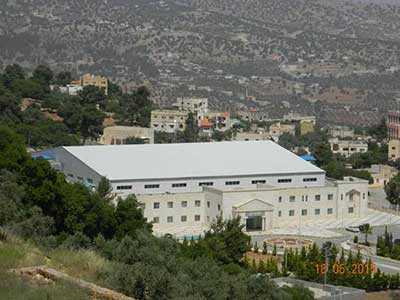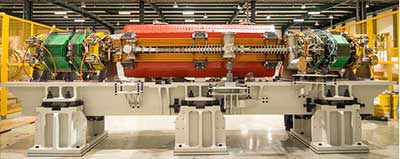SESAME Moves towards Commissioning
Chris Llewellyn-Smith

Photo: SESAME
The SESAME building, 35-km north-west of Amman, seen with its new roof in May 2015

Photo: CERN-PHOTO-201503-059-57
The first of 16 cells of the SESAME storage ring, assembled for testing at CERN in late March, with components constructed in SESAME members and observers: quadrupoles (green) – Spain and Turkey; dipoles (red) – UK; sextupoles (yellow) – Cyprus and Pakistan; sextupole coils – France; vacuum chambers – Germany; girders – Spain. In addition, there are: dipole power supply – Italy; controllers and corrector power supplies – Switzerland; quadrupole and sextupole power supplies – Israel
If all goes well, commissioning will begin in the second half of next year. What barriers have been surmounted in reaching this stage, and what are the remaining challenges?
Progress in construction
It was originally proposed that SESAME would be a 1 GeV light-source based on components of the BESSY I facility in Berlin (for a history of SESAME see www.sesame.org.jo). In 2002, however, it was decided to build a completely new 2.5 GeV main storage ring, with straight sections that can accommodate insertion devices, while retaining the main elements of the BESSY 1 microtron, which provides the first stage of acceleration, and the booster synchrotron.
The building, which was provided by the Jordanian government, was formally opened in November 2008. Other progress has not been as rapid as had been hoped, due mainly to lack of funding. The collapse of the roof under unprecedented snowfall in December 2013 (when it even snowed in Cairo) has not helped, although – despite working under the open sky throughout the year – the SESAME team successfully commissioned the 800 MeV booster in September 2014.
The final design of the magnets for the main ring and the powering scheme was carried out by CERN in collaboration with SESAME. Construction of the magnets is being managed by CERN using funds provided by the European Commission. The first of 16 cells was assembled and successfully tested at CERN at the end of March: installation will begin later this year. If all goes well, commissioning of the whole facility – initially with two beamlines and two of the four accelerating cavities – should begin in June next year.
Training
From the start SESAME has organised a vigorous training programme, with generous support from Agencies and laboratories around the world. Initially the emphasis was on training accelerator experts, but it has now shifted to training beamline scientists and potential scientific users of SESAME. The potential user community already numbers some 300 and is expected eventually to grow to 1,000 to 1,500.
The scientific programme
SESAME will nominally have four ‘day-one’ beamlines in Phase 1a, although – to speed things up and to save money – it will actually start with just two (Infrared - a thermal source Fourier Transform Infrared microscope, that will be used with this beamline, has been in use in experiments since last year; and X-ray Absorption Fine Structure and X-ray Fluorescence). Two more (Macro-molecular Crystallography; and Materials Science) will be added in the next two years, once the necessary funding is available. Three others will be added in Phase 1b (Soft X-ray; Small and Wide Angle X-ray Scattering; and Extreme Ultraviolet). This suite of beamlines will enable research in subjects ranging from biology and medical sciences through materials science, physics and chemistry to archaeology.
Challenges
The main challenge has been, and is, obtaining funding. Most of the SESAME Members have tiny science budgets and face financial difficulties, and they do not find it easy to pay their contributions to the operational costs, which are rising rapidly as more staff are recruited, and will increase even faster when SESAME comes into operation and is faced with paying large electricity bills, at $0.36/kWh and rising (a solar power plant that will cover part of the need will be constructed once the funding can be found). Increasing budgets have been approved by the SESAME Council, but more Members, which SESAME has always sought, primarily to share the benefits, would provide some relief.
So far $65 M has been invested, including the value to SESAME of in-kind contributions of equipment (from Jordan, Germany, UK, France, Italy, USA, and Switzerland), cash contributions to the capital budget (from the EC, Jordan, Israel, Turkey, and Italy), and manpower and other operational costs that are paid by the Members (but not including important in-kind contributions of manpower from CERN and the French light-source SOLEIL).
Thanks to major contributions from the EU and Italy, and pledges to voluntarily provide $5 million each (much now paid) by Iran, Israel, Jordan and Turkey, most of the funds that are required simply to bring SESAME into operation next year are now available. At the SESAME Council meeting in May, Egypt announced that it will also make a voluntary contribution, which will narrow the immediate funding gap. More will, however, be needed to provide additional beamlines and a properly equipped laboratory, and additional funds are being sought from a variety of governments and philanthropic organisations.
It would be wonderful if the USA could match, or exceed, the $11 million so far contributed by the European Union. Over many years various Departments of the US Government have expressed support for SESAME, and in 2010 the US National Commission for UNESCO endorsed SESAME as ‘an initiative that supports the diplomatic interests of the United Sates’. So far, however, this has not resulted in support (apart from some training opportunities and donations of surplus equipment). We hope that recent letters urging US support, to the President from Representative Bill Foster and four colleagues, and from Rush Holt CEO of the AAAS (who, with Foster and others, wrote to Hilary Clinton about SESAME in 2009) to Secretary of State John Kerry, will produce results. Any pressure that APS members can exert, directly or through members of the Congress, could help.
The on-going turbulence in the Middle East has only had two direct effects on SESAME. First, sanctions have up to now made it impossible for Iran to pay its capital and operational contributions, which are very much needed. Second, discussions of Egypt joining other Members in making voluntary contributions were interrupted several times by changes in the government.
Conclusions
Senior scientists and administrators from the SESAME region are working together to govern SESAME through the Council, with input from scientists from around the world through its Advisory Committees. Young and senior scientists from the region are collaborating in preparing the scientific programme (at Users’ Meetings and Workshops). And the extensive training programme (Fellowships, Visits to operating light-sources, Schools) is already building scientific and technical capacity in the region.
There are still huge challenges, but I am confident that thanks to the enthusiasm of all those involved they will be met. There are light-sources with higher energy and greater brightness, but SESAME’s performance should be good enough to attract leading scientists from across the region. The scientists who work together at SESAME will quickly develop professional respect, which in turn will lead to greater mutual tolerance and understanding for their diverse views on non-technical issues. In the words of an endorsement of SESAME issued by 45 Nobel laureates, SESAME is expected to become “a beacon, demonstrating how shared scientific initiatives can help light the way towards peace”.
Professor Chris Llewellyn-Smith is President of the SESAME Council and Director of Energy Research, Oxford University and formerly Director General of CERN.
Disclaimer - The articles and opinion pieces found in this issue of the APS Forum on International Physics Newsletter are not peer refereed and represent solely the views of the authors and not necessarily the views of the APS.
